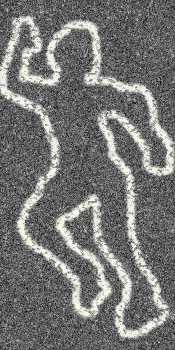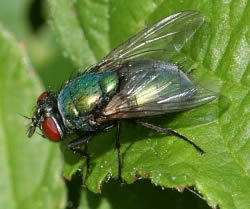Forensic entomology

Insects can help determine the time and location of death as well as revealing many other suprising facts.
CSI Entomology: Insects at the scenes of crime
How long has she been dead?
Was the corpse moved after death?
What did he die of?
Difficult questions if you are a police officer investigating a possible murder.
A knowledge of insects can help supply the answers.
Criminals often try to hide their own forensic trail, but they rarely think of the clues they leave behind which can be read by forensic entomologists.
At the scene of a crime, a forensic entomologist will:
- record the number and kinds of adult and immature insects within 3 - 6 metres of the body
- note the surrounding habitat type, which will suggest what insects to expect there
- note the body's exact position, its exposure to light, and the time of day
- note any unusual phenomena which could affect insect activity - such as burial, or the presence of trauma
What insects might the forensic entomologist find?
The first type of insect to arrive at a dead body is usually a blowfly (Calliphoridae), attracted by body fluids and gases. It lays its eggs within two days after death, so its stage of development - egg, larval stages, prepupal or pupal stage, adulthood - will suggest how long the corpse has been lying undetected. Ambient conditions affect both how soon after death the blowflies arrive and how quickly the maggots develop.
Then, as the body decays due to microbial fermentation, flesh flies (Sarcophagidae) are attracted to it.
Later, decomposition of body fat attracts hide beetles, and a Pyralid moth in the genus Aglossa might arrive. And after three to six months, protein breakdown attracts other insects, such as the cheese skipper Piophila casei.
Necrophagous species, also called carrion feeders (mainly flies and beetles) actually consume dead flesh. Others, like Rove Beetles (Staphylinidae) are predatory on the carrion feeders.
Among the beetles, the Dermestidae occur at the later stages of decomposition; then, when these turn up, members of the Hesteridae may also arrive - these are predatory on Dermestidae larvae.
What if the insects found on the body are not those expected?

The blowfly Lucilia sericata is a species of both veterinary and forensic importance.
If blowflies are found on a corpse which is in a closed environment, that could mean that the body might have been moved there after death.
And different blowfly species prefer different environments - warm or cool, urban or rural. So, the presence of the 'wrong' species for the location where the body was found could be suspicious.
The insects found underneath the body will also vary with the length of time the body has been at the scene, providing more evidence of both time of death and whether the body may have been moved.
In the colder months the winter gnats (Trichoceridae) may lay eggs on a carcass. Conicera tibialis, the coffin-fly, is associated with coffined bodies that have been underground for about a year. The adult can bury to a depth of 50 cm in about four days. Its development is slow at normal grave depths (1 - 2 metres) and takes place independently of the seasons.
The Coelopidae flies, which are identifiable from their flattened thoracic dorsum and bristly legs, occur along the seashore, and could be evidence that the body has lain on a beach.
What about the cause of death?
Insects themselves can be the cause of death! Wasp stings can induce a severe allergic reaction, called anaphylaxis; or they can kill a small child locked in a room full of wasps; or they can cause an accident if a driver is stung while driving.
Poisons may also be detectable in larvae feeding on a corpse, or in skin casts or puparia, even if it is too late to sample the corpse's blood or stomach contents. Some poisons, such as the insecticide Malathion, will influence the insects found.
Insects can also be useful in less grizzly cases - for example, they can help identify the source of illegal drugs. If the drugs have been imported, foreign stored product pests may be present in the drug consignment.
![Amateur Entomologists' Society home page [Logo]](/images/aes-logo-wplant.gif)